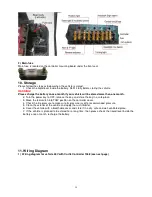
16
9) BATTERY CHARGING
WARNING!
Before you use the charger, please read the operation manual provided with the charger.
WARNING!
Explosive hydrogen gas is produced while battery is charging. Only charge the battery in well-ventilated
areas.
WARNING!
Before using the charger, please check to make sure the battery charger you are getting is correctly rated
as per your local AC electricity network.
WARNING!
When using a new battery, make sure the new battery is of the same specifications as the original one and
is appropriate in application.
Following are the 9 charging steps:
1) Turn the ignition key to OFF position and pull it out.
2) Connect the plug to the vehicle receptacle first; then connect it to your local AC power outlet.
WARNING!
Do not disconnect the cord from the battery receptacle when the charger is ON, otherwise an arc
could occur which may cause an explosion. Always disconnect the battery receptacle first, then
disconnect from the AC power outlet.
3) The charger will turn off automatically when the battery is charged fully.
WARNING!
The battery receptacle is combined with a security switch which can cut off the power of the vehicle when
the battery is being charged, so the vehicle cannot be started as long as the battery receptacle is plugged.
4) After the charger turns off, disconnect the plug on the AC charging cable from the AC power outlet first,
and then disconnect the DC output plug from the vehicle receptacle.
5) It is prohibited to open the housing of the charger.
6) Only a qualified electrician is allowed to open the housing of the charger.
7) The charger should be stored in a safe and dry room with good ventilation.
8) The charger should be packed properly if not used for a long time.
9) Read carefully the operation manual for the charger for detailed operation instructions.
5.2 The operation and maintenance of charger
Note:
As standard configuration, the charger is built in the vehicle; in some cases, it may not be built in the
vehicle. If it’s built in the vehicle, the position of the charger is either under the seat or the bag well or front
body.
The procedure to use the charger (when the charger is built in the vehicle).
1. Connect the cord to the receptacle on the vehicle;
2. Connect the cord to the receptacle to the outlet of household grid.
3. After the charger cord is connected, the red indicator on the charger will flash, the charger starts the
procedure of self-inspection, after self-inspection, green indicator flashes, and charger starts to charge
the batteries.
4. When battery capacity is less than 80%, the green indicator flashes slowly; when battery capacity is
more than 80%, the green indicator flashes fast; when the battery is fully charged, the green indicator
will stop flash and always be on, and the charger will stop charging automatically.
Note
: This charger has the function of over-discharging protection to protect the battery from
over-discharging. When the battery is close to the charging point, it will reduce the discharging current from
the battery to reduce the speed of the vehicle, if user does not recharge the battery, it will cut the current
from the battery and stop the vehicle to force the user to charge the battery.
Note:
When the grid voltage is out of range of 90-260V, the charger will stop charging to protect itself, in the
same time, the failure code light will be on to remind users. When the voltage returns back to the requested
voltage range of 90-260V, it will automatically start to charge.
Note: The charger will automatically start equalizing charge after 30 times of charging if maintaining a
charge connection from the grid and battery after the battery is fully charged.













































